
In today’s privacy-first world, customer trust is essential to driving loyalty and business success. But how is increasing consumer trust with email marketing possible in today’s digital world, where spammers have made many people suspicious of every email that lands in their inboxes?
That’s where email marketing techniques to increase consumer trust come in. Consider this: According to a McKinsey & Company survey, only 33% of customers believe that companies use their data responsibly:
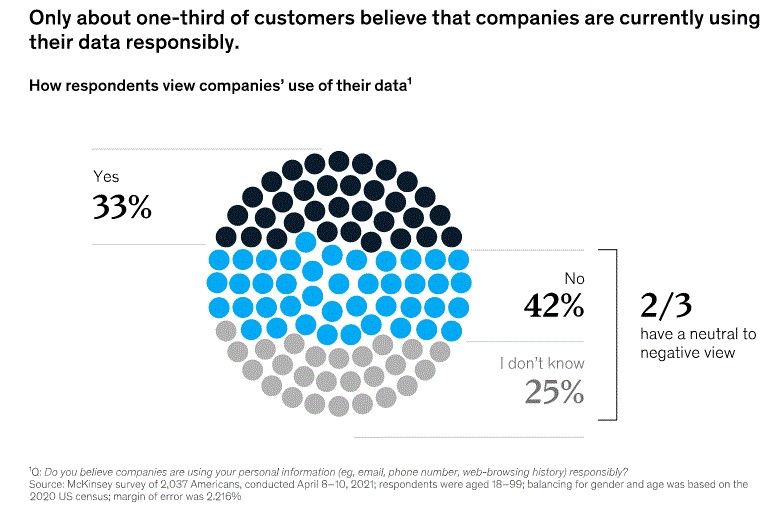
What does this mean? This is a clear indication that there is more to be done if you want to increase consumer trust. And many benefits come with building it.
Not only does consumer trust help improve brand reputation, but it also improves engagement. And with a more engaged audience that trusts your brand, you can generate more sales.
Statistics prove it. 57% of consumers are likely to pay more when purchasing from brands they trust. Read on to learn how to build and increase consumer trust with your email marketing strategy.
1. Let Consumers Know How Their Personal Data Will Be Used
One of the most powerful email marketing techniques to increase consumer trust is to have clear privacy and opt-in policies. Think about it. 46% of customers often or always consider another brand if the one they are planning to purchase from doesn’t have clear policies about how it intends to use their data:
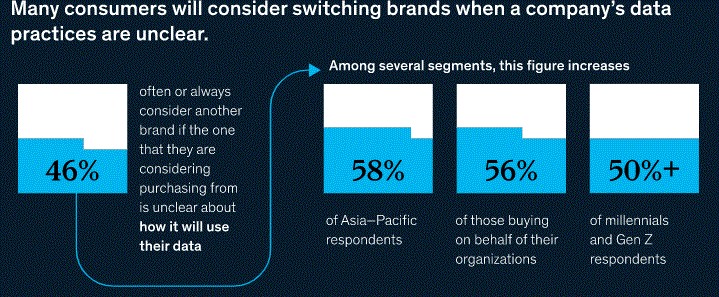
Customers want clarity about how their personal information will be used. To help increase their trust, let them know how you intend to use their data during the opt-in process. Keep it really simple.
Here is an example of a good opt-in form by Discover Magazine:
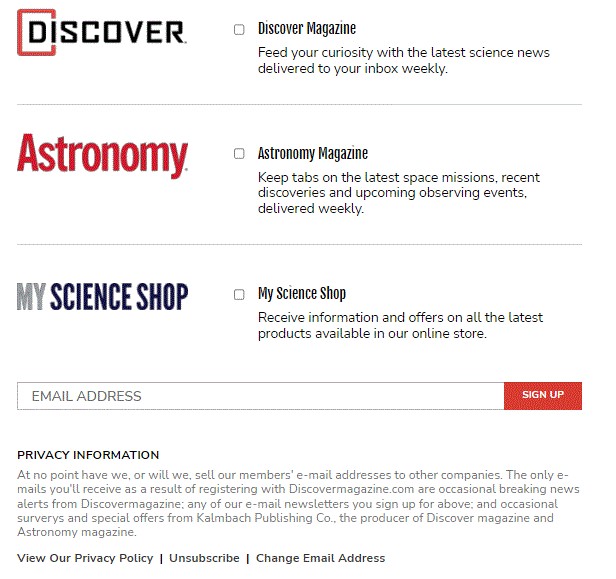
As you can see, Discover Magazine lets its subscribers know exactly what types of emails they will receive after subscribing to the newsletter. The subscribers are also informed that their email addresses will not be sold to other companies. And you can also read their privacy policy by clicking on the hyperlinked texts or unsubscribing right away.
Having clear privacy and sign-up policies can make a huge difference in your opt-in rates. You may also go the extra mile and create a double opt-in to ensure you’ve earned your customers’ trust first. In this case, the customer will need to verify their email addresses after signing up for your newsletter. This will help to weed out spam accounts so that you can add only those people who are actually interested in your business.
2. Seek Permission Before Sending Emails
Sending certain emails to customers who have not explicitly permitted you to do so is one of the bad email marketing techniques that break customer trust. It could hurt your engagement and conversion rates. Besides, it could drive many people to unsubscribe from your email list.
It’s important to ensure your email marketing campaigns are GDPR compliant by seeking a customer’s consent before using their email details. You can achieve GDPR compliance by creating a pop-up on your website that asks users to accept or reject cookies used on the page. Additionally, you can allow people to opt-in to some or all of your email marketing campaigns at the time when they are signing up for your newsletter. Finally, make sure that the email marketing platform you use follows GDPR and all of the other compliance rules and regulations, as some of the more popular platforms may not (such as Mailchimp).
The following is a great example of an email newsletter opt-in form by Insider Intelligence:
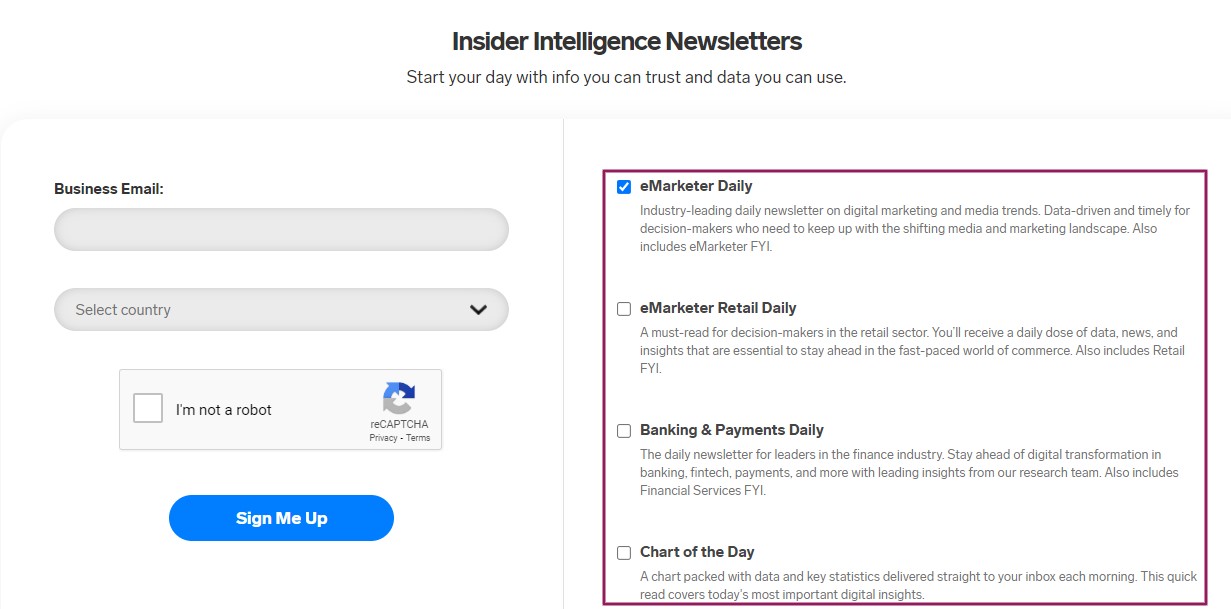
As you can see on the right-hand side of the signup form, you can check the boxes for the types of emails you want to receive from Insider Intelligence. When you do that, you’re permitting them to send you such emails. That’s the key to ensuring that they’ve opted to receive emails from you. If that isn’t the case, don’t move ahead. No matter what.
3. Send Your Email Campaigns to the Right Audience
To increase consumer trust effectively with email marketing, you need to start by targeting the right audience with your emails. Sure, you may have built your email list to have a huge number of consumers. But that doesn’t mean that all of them have the same likes or preferences. That’s where buyer personas can help you.
By segmenting your audience into different personas, you can figure out which email might click with what segment. Accordingly, you can send emails to different segments by leveraging your CRM tools.
The result? The relevancy of emails will skyrocket. This will lead to better results for your campaign. At the same time, consumers will see that you’re sending relevant stuff their way. This will build trust.
4. Humanize Your Email Marketing
When executing email marketing campaigns, you must understand that the whole process is aimed at connecting you with your prospective customers, who are humans. This is one of the best email marketing techniques to increase consumer trust because it helps you to build stronger connections with the recipient.
To write emails that have a human touch, use language that your target audience can relate with. Ensure your messages are conversational.
You can also play around with the email design. Some customers prefer email designs with certain colors. Try to test your email to see what colors drive more engagement or product purchases as well.
Here are other useful tips for humanizing your email marketing campaigns:
- When sending automated emails, ensure you decide on a credible sender name to build credibility and trust for the recipient.
- Ask a relevant question in your emails to encourage engagement.
- Add visual content to make your emails engaging.
- Schedule emails for appropriate times.
- Mention the recipient’s name when sending emails.
5. Use Social Proof
Using social proof isn’t only an email marketing technique to increase consumer trust but can also help you close sales. Think about it.
94% of consumers say reviews impact their purchase decisions:
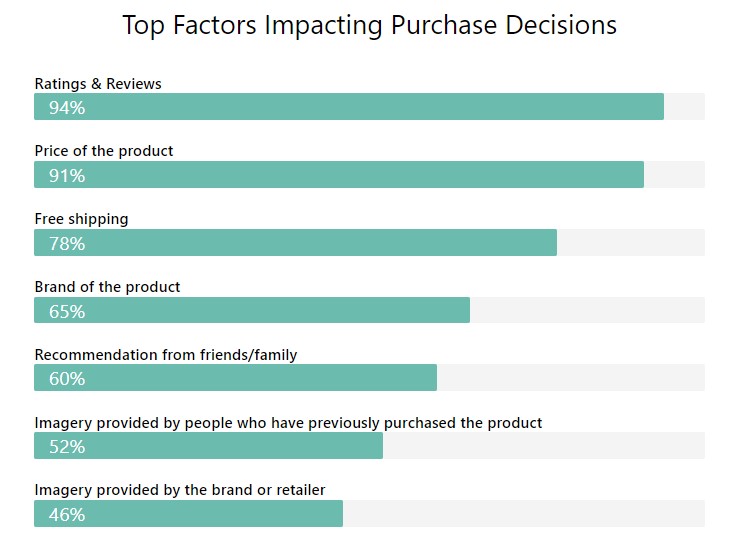
Besides, 79% of customers trust customer reviews as much as recommendations from their own friends and family members. This is the power of social proof.
Now figure this. During your first interactions, you will have customers that require more time and convincing to truly trust your company. This is where social proof becomes helpful.
So, normalize sharing testimonials and referrals when sending your marketing emails to show your contacts how others have already benefited from your offers. You can even use video marketing tools to create testimonial videos and embed those into your emails.
Here are practical ways to use social proof in your email campaigns:
- Highlight real customer reviews and testimonials with Google review widgets.
- Share your numbers.
- Show products other customers are purchasing or have purchased.
- Share user-generated content.
- Showcase expert recommendations.
- Share case studies.
- Add social proof to your email signature.
Adding the email signatures below the email text body helps in boosting the trust among the receivers. You can use the best email signature generator software to create awesome email signatures.
6. Personalize Your Email Marketing
Another one of the most powerful email marketing techniques to increase customer trust is personalization. And it works.
For instance, according to a 2022 McKinsey & Company survey, 76% of consumers say they are most likely to consider purchasing from brands that personalize their marketing efforts, and 78% of consumers say personalization makes them make repeat purchases.
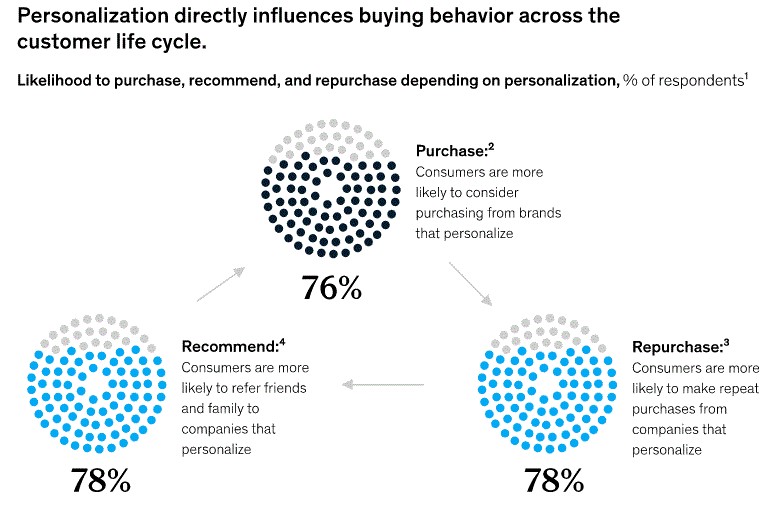
Personalization is important since 73% of consumers expect companies to understand their unique needs and expectations.
Similarly, 56% expect companies to send them personalized offers:
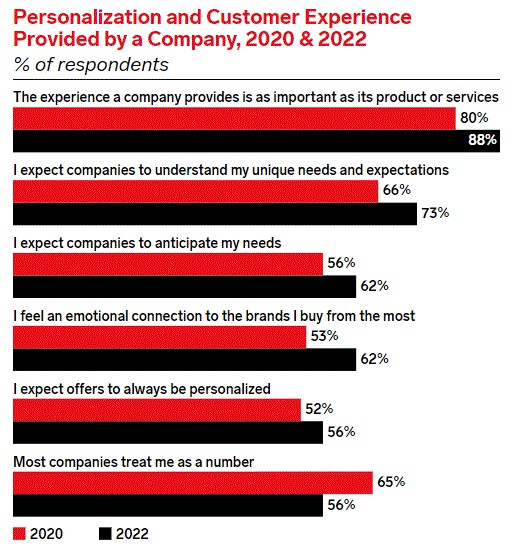
As you can see, consumers want to feel that you understand and appreciate their uniqueness. By personalizing your email campaigns, you can increase engagement rates significantly.
Besides, email personalization can help you with the following:
- Boosting open and click-through rates.
- Reducing unsubscribe rates.
- Improving customer satisfaction.
- Re-engaging customers.
7. Welcome New Subscribers
Your welcome email can help you make a solid first impression with new subscribers. In addition to letting your subscribers know what type of emails you’re going to be sending through your opt-in form, you can reiterate this in your welcome email.
Here are some of the benefits of welcome emails:
- Make subscribers feel appreciated.
- Help to set expectations.
- Help subscribers familiarize themselves with your brand.
- Provide additional information about your products.
- Contribute to the overall brand experience.
- Remind customers why they subscribed to your email list.
- Invite engagement.
Here is a simple welcome email by Animoto:
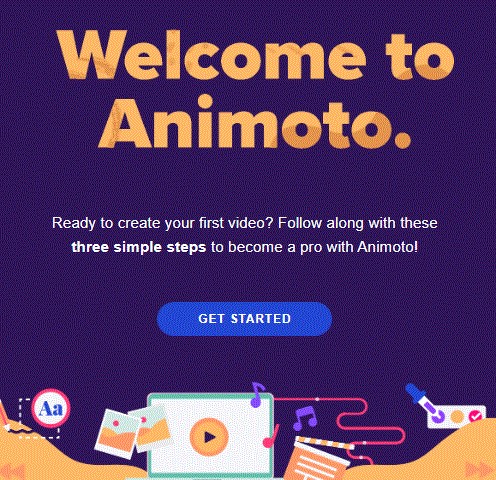
Here are handy tips for writing great welcome emails:
- Keep your subject lines conscious and interesting. As simple as “Welcome to “mention your brand!”
- Personalize your emails.
- Emphasize the benefits of subscribing.
- Include links for more relevant information.
- Include a visible and compelling call to action.
8. Use Email Marketing Automation
The timing of your emails can greatly help you in building consumer trust. When someone subscribes to your email list or engages with your brand, you need to respond to them immediately. This not only proves your attentiveness to your customers but also shows how reliable you are. But this is easier said than done, especially when you have a lot of things to do. That’s where autoresponders and drip campaigns can help you.
Autoresponders and drip emails come into the picture when you send an email to specific customers after they take a certain action, such as clicking a link, subscribing to your email list, making a purchase, etc. For this, you can use an email automation tool like Smaily to send effective automated emails.
According to a 2021 Litmus State of Email report, 83% of marketers say they use automation when sending welcome emails, and 68% use it for customer onboarding or post-purchase emails:
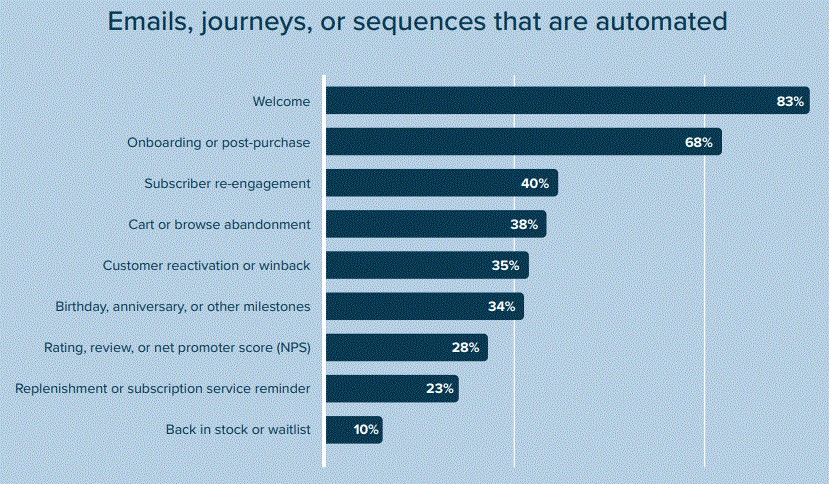
Note that when using email marketing automation, you should focus on sending high-quality and personalized email content rather than spam.
Increasing Consumer Trust With Email Marketing: Conclusion
Building consumer trust on the internet today has become more challenging than ever, thanks to the widespread scammers who have made consumers more skeptical and conscious.
However, you can use these eight effective email marketing techniques to increase trust, build lasting relationships with customers and drive more sales. So, go ahead and start leveraging them well to take your business to new heights.
About the Author
 Reena Aggarwal is the Director of Operations and Sales at Attrock, a result-driven digital marketing company. With 10+ years of sales and operations experience in the field of e-commerce and digital marketing, she is quite an industry expert. Reena is a people person and considers human resources as the most valuable asset of a company. In her free time, you would find her spending quality time with her brilliant, almost teenage daughter and watching her grow in this digital, fast-paced era. You can check out Reena’s Twitter here.
Reena Aggarwal is the Director of Operations and Sales at Attrock, a result-driven digital marketing company. With 10+ years of sales and operations experience in the field of e-commerce and digital marketing, she is quite an industry expert. Reena is a people person and considers human resources as the most valuable asset of a company. In her free time, you would find her spending quality time with her brilliant, almost teenage daughter and watching her grow in this digital, fast-paced era. You can check out Reena’s Twitter here.